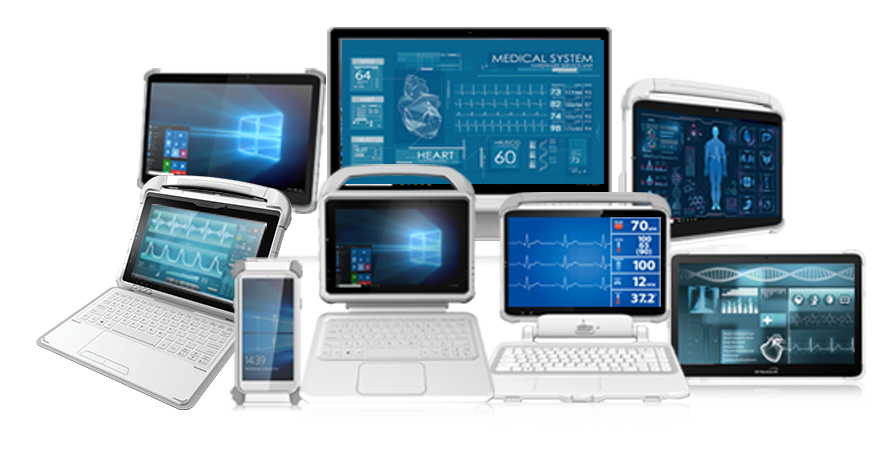
In the rapidly evolving landscape of healthcare technology, the choice between a Medical All-in-One (AIO) computer and a Medical Tablet can significantly impact the efficiency and functionality of medical facilities. Understanding the unique features and use cases of each is crucial for healthcare professionals aiming to optimize their workflows and enhance patient care.
Medical All-in-One: Large Screens and Powerful Performance
One of the distinguishing features of Medical AIOs is their expansive 21.5” to 27” screens, providing a large display area for medical professionals. The inclusion of powerful graphics processing, featuring NVIDIA GPU and 4k resolution, ensures clear and detailed imaging, vital for medical diagnostics and viewing complex medical data.
Mobility is streamlined within a specific department or area, allowing medical staff to access patient information and medical records seamlessly. The versatility of these VESA mountable computers is evident in their ability to serve as a centralized hub for various medical tasks, contributing to enhanced productivity within a specific workspace.
The Medical AIO from DT Research is designed with features such as hot-swappable batteries, cameras for telehealth, RFID scanners, and fanless clean operation. This space-saving all-in-one is 60601 certified, meeting the stringent safety and performance standards required in medical settings. The Windows 11 IoT Enterprise operating system further enhances the user experience with its modern interface, improved security features, and compatibility with medical software.
Medical Tablets: Portability and Versatility
On the other hand, Medical Tablets offer a diverse range of screen sizes, ranging from 6” to 17”. This wide range makes them ideal for various applications, from handheld scanning of patient IDs, asset management, and equipment inventory to serving as a wide-screen tablet for viewing medical imaging. The ultra-portable nature of these tablets makes them suitable for use between buildings, large campuses, remote locations, and field clinics.
Despite their smaller size, Medical Tablets do not compromise on essential features. They, too, come equipped with hot-swappable batteries, cameras for telehealth, RFID scanners, and adhere to the rigorous 60601 certification standards. The compact design of these medical tablets saves space and allows for easy integration with an additional screen, facilitating dual-monitor setups for specific medical tasks.
DT Research’s lineup of Medical Tablets ensures clean operation, consistent connection no matter the location and BT connectivity, and the reliability demanded by healthcare professionals. The robust tablets run on the Windows 11 IoT Enterprise operating system, providing a familiar and user-friendly interface that enhances operational efficiency.
Choosing the Right Device for Your Healthcare Facility: A Brief Guide
The decision between a Medical All-in-One (AIO) and a Medical Tablet plays a pivotal role in shaping the efficiency and effectiveness of your healthcare facility. Let’s delve into the considerations that can help you make an informed choice tailored to the unique needs of your medical environment.
Medical AIO: Power and Centralization
Medical AIOs, characterized by their expansive 21.5” to 27” screens, are designed for dedicated departments that benefit from larger displays and centralized functionality. These devices become the hub for crucial medical tasks, offering powerful graphics processing with features like NVIDIA GPU and 4k resolution. This not only ensures clear and detailed imaging, but also contributes to enhanced productivity within a specific workspace.
The DT Research Medical AIO lineup comes equipped with indispensable features such as hot-swappable batteries, cameras for telehealth, RFID scanners, and adherence to the rigorous 60601 certification standards. The integration of the Windows 11 operating system further elevates the user experience, providing a modern and secure platform that aligns seamlessly with the demands of contemporary healthcare environments.
Medical Tablets: Flexibility and Mobility
In contrast, Medical Tablets offer a diverse range of screen sizes, spanning from 6” to 17”. This versatility makes them an ideal choice for on-the-go tasks across various medical settings. Whether it’s handheld scanning of patient IDs, assets, and equipment or serving as a wide-screen small-footprint tablet for viewing medical imaging, these tablets provide the flexibility needed in dynamic healthcare environments.
DT Research’s Medical Tablets maintain essential features such as hot-swappable batteries, 4K cameras for telehealth, RFID scanners, and adherence to the critical 60601 certification standards. The compact design of these tablets not only saves space, but also allows for easy integration with additional screens, facilitating dual-monitor setups for specific medical tasks. Operating on the Windows 11 platform, these tablets offer a user-friendly interface that enhances operational efficiency.
Making the Informed Choice
In the end, the decision between a Medical AIO and a Medical Tablet hinges on the specific needs and workflows of each healthcare facility. If the aim is to enhance functionality within dedicated departments with larger screens and centralized tasks, the Medical AIO might be the optimal choice. On the other hand, if your workflows demand flexibility and mobility for tasks across diverse medical settings, the Medical Tablet could be the ideal solution.
Regardless of your choice, both product lines from DT Research ensure essential features such as hot-swappable batteries, telehealth-ready cameras, RFID scanners, and compliance with the rigorous 60601 certification standards. The integration of the Windows 11 IoT Enterprise operating system guarantees a seamless and secure user experience, meeting the high standards expected in modern healthcare environments.
In conclusion, the right IT for your healthcare facility depends on finding the perfect balance between power, flexibility, and adherence to industry standards. By understanding your specific needs, you can make a strategic choice that enhances the efficiency and quality of patient care in your medical setting.

